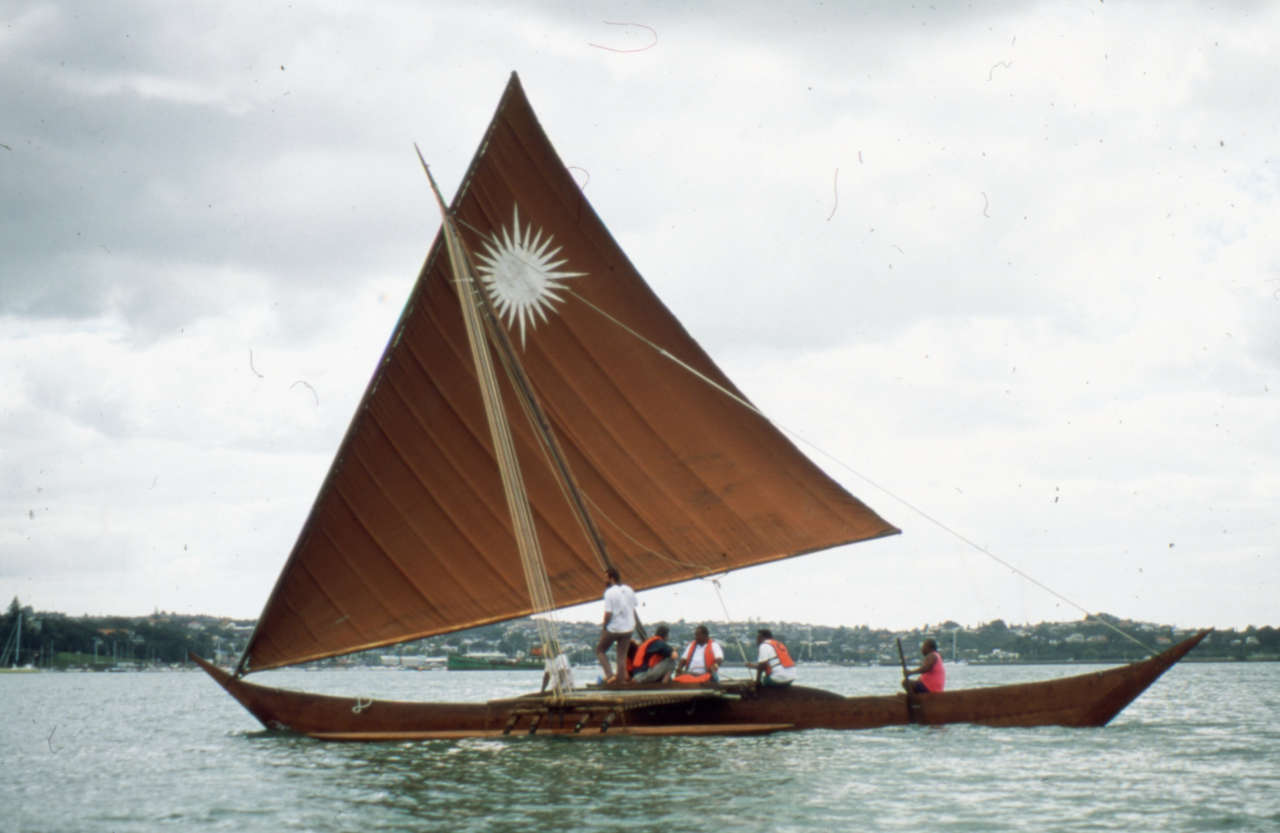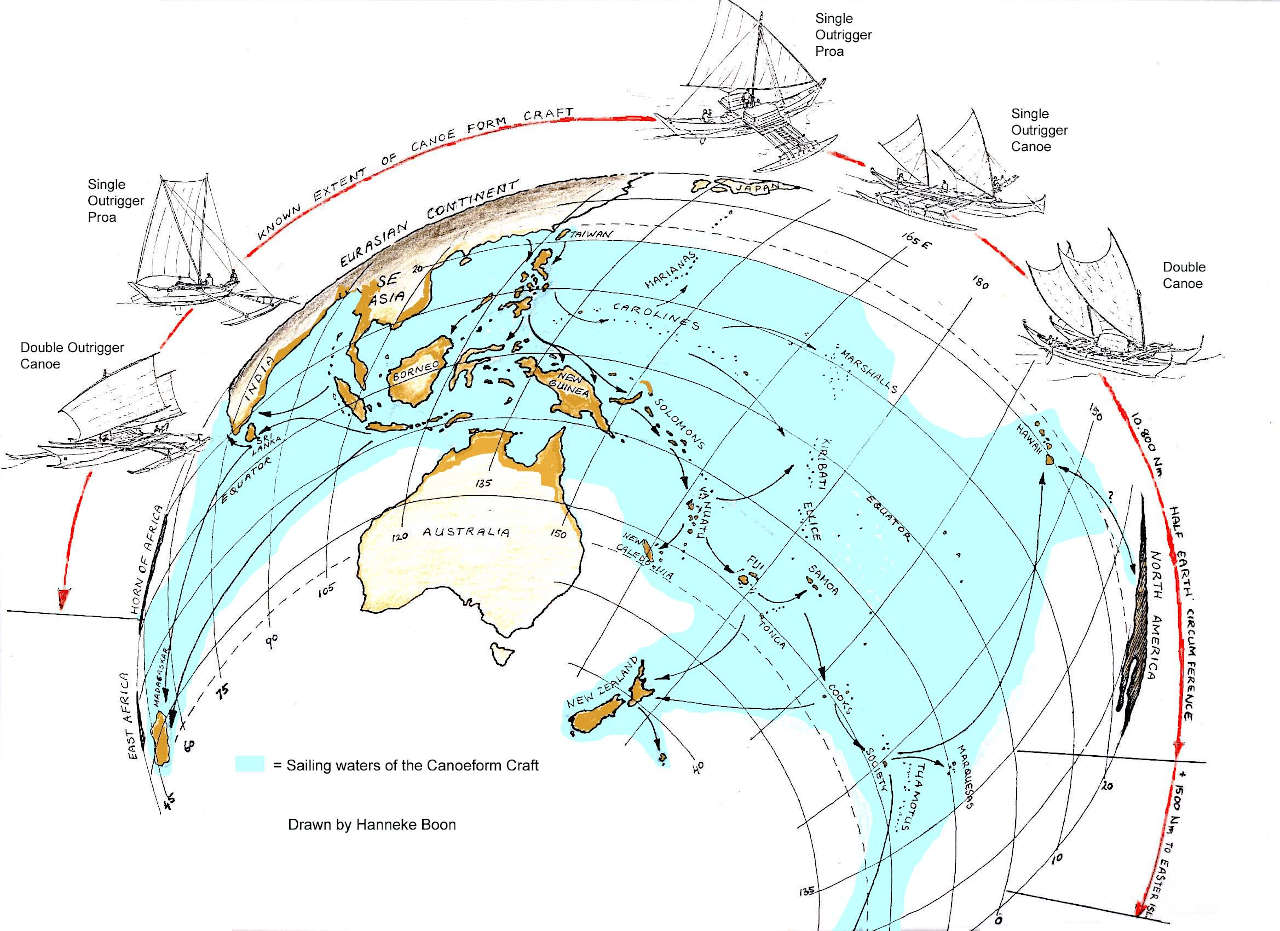
In February 1998 an interesting debate held at the Royal Lymington Yacht Club with the motion: "This house believes that the future of cruising yachts are the fast, light displacement boats that are fun to sail and that are seaworthy."
At this public debate the two sides of british yacht designers had gathered, the extreme 'modern' and the more traditional designers. The term 'Light Displacement Boat' was meant to mean the highly expensive modern monohulls with deep fin keels and tall, high tension masts. "and that are seaworthy" shows that the proposers consider some modern light displacement boats lack seaworthiness.
In general, the phrasing of the motion implied a disappointing lack of knowledge of the world's sailing craft, for seaworthy, light displacement cruising craft - coastal and ocean - have been around for thousands of years and have been, and are being, adapted for present day sailors.
The Viking ship was a light displacement craft, and modern descendants of such craft, like the Norwegian fishing boat the 'FEMBORING' or some of Ian Outrecht's excellent Viking era style craft are "fun to sail" and like FEMBORINGs are seaworthy craft.
Long before the Viking ship era, 800 - 1100 AD, - long, long before that, about 10,000 years ago at the end of the Ice Age - fast, light displacement Canoeform Craft, started migrating out from areas around Taiwan (long before Chinese settlement) and continued from Indonesia across oceans against prevailing winds to eventually settle Hawaii, New Zealand and across the Indian Ocean to Sri Lanka, South India and Madagascar (which is just off Africa) - see the chart.
This ocean wide settlement of over half the world's circumference - took about 8,000 years; 8,000 years during which the principles of the Canoeform light displacement sailing ship evolved not by 'Regulations' but in the organic way of a living creature like a seal, dolphin or seaotter - their evolution speeded up by the minds and wishes of practical sailors.
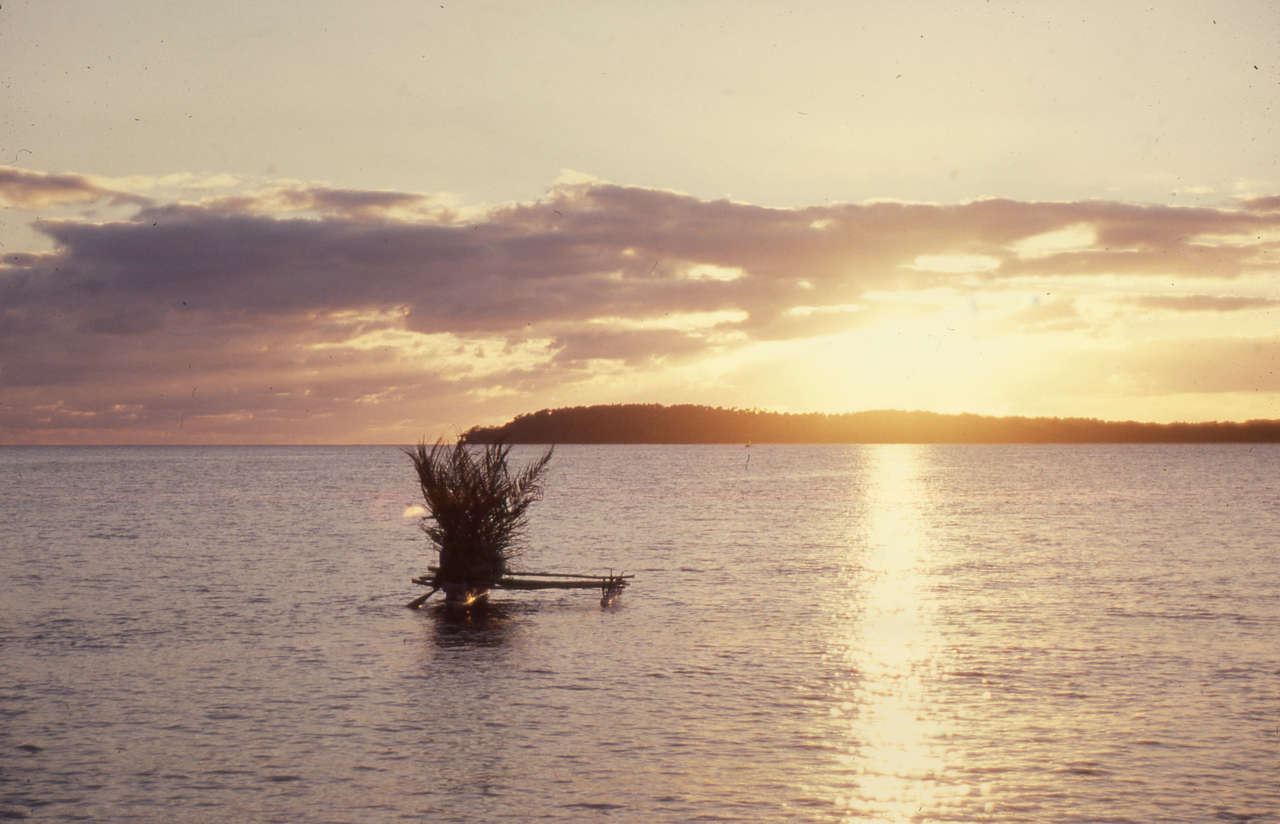
The First Sailors
This school of practical sailing design has existed longer than most people realize. The latest palaeo/anthropological studies of the evolution of humans show that the island of Flores in Indonesia was 'settled' 800,000 years ago. Flores has always been an island and the 'settlers' must have travelled by watercraft to get there. However, Man, Homo Sapiens, you, me, Asiatics, Africans and the rest of the present day world population have only evolved out of Africa in the last 100,000 years!! (This is the majority opinion, disputed by a few Asian Anthropologists). Therefore, watercraft of some sea survivable type were being used by what has so far been popularly presented as the semi animal/pre human Homo Erectus some 700,000 years "'before"' the Homo Sapiens species developed!!
There is a less arguable later date of the settlement of Lombok from Bali 250,000 years ago, but again 150,000 years before our ancestors walked out of Africa. The evidence shows seagoing watercraft existed before 'Man' existed!! Homo Sapiens only settled Australia by watercraft 60,000 years ago.
Archaeological evidence shows the next wave of modern Man spreading and migrating out of the Eurasian Continent from the end of the Ice Age 10,000 years ago, not by foot but by sea-going craft. (Whether they would have been allowed to do it under the proposed 'Recreational Craft Directive' is highly doubtful). For interest, the first wheeled land vehicles were only invented about 6,000 years ago.
Small boat sailing is so old, it is a deep, instinctive part of our behaviour pattern like throwing a stone (inherent in cricket, football, tennis and other ball sports) wishing to light fires or find peace in the quiet sound of moving water. It is the reason for the world wide Classic Boat revival in recent years. Readers of this magazine and others like it, have an 'instinctive' feeling that something has got lost in recent sailing craft and sailing attitudes. Our ancient sailing history explains the roots of their instinctive feelings.
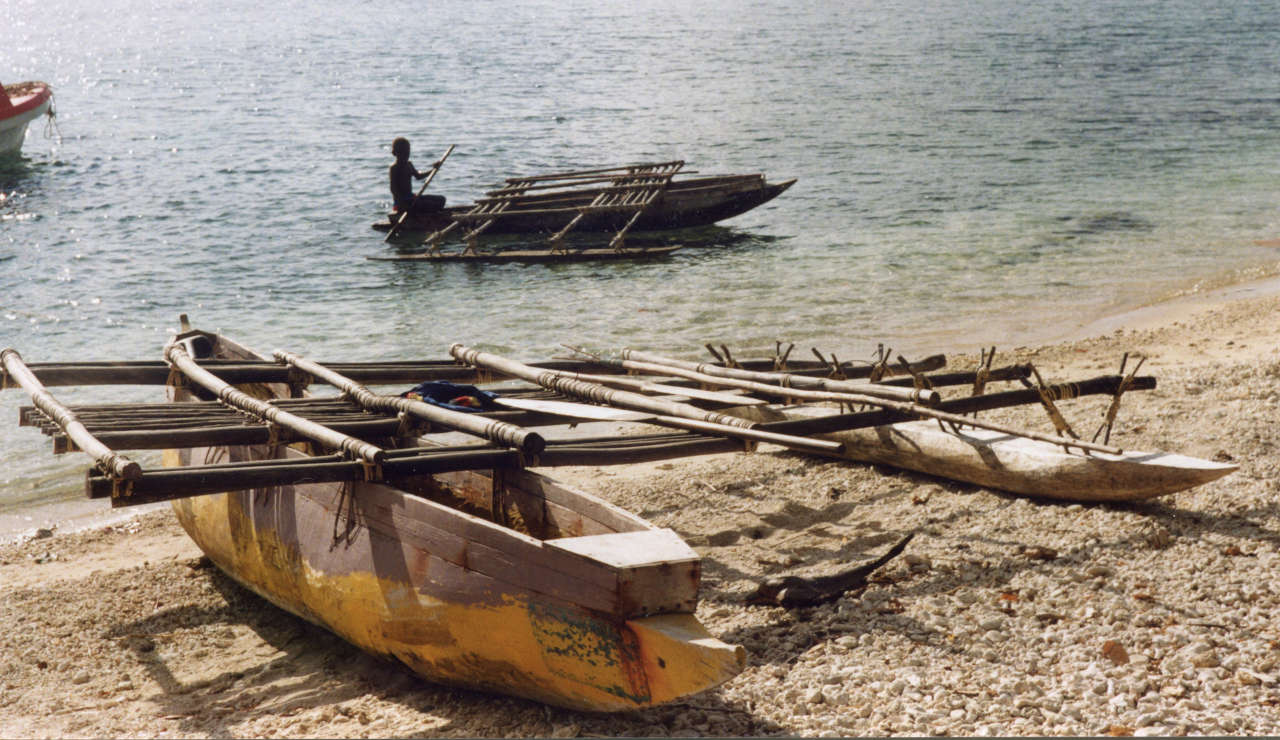
Sea People
As most of urban man are in in-debt slavery to a life mortgage to buy their house, modern yachts that cost as much as their home are no longer affordable to a major group of would be sailors.
One reason for the expense of modern yachts, multihulls or mono, is that they are increasingly designed to accommodate the body comfort and mental attitudes of soft urban Man.
Some rare souls like Frank and Margaret Dye adapted their bodies and mental attitudes to the sea (as all sea-going people until relatively recently) and with minimal expense have sailed their 16ft. camping WAYFARER around Europe through fine weather and foul to experience the joy of becoming 'People of the Sea'.
In 1997, Rory McDougall completed a round the world voyage on a Wharram 21ft. TIKI. He, too, as described in his articles, adapted himself to the sea.
On many Oceanic archipelagos in the ancient Canoeform World, suitable stone for tools was in short supply, suitable boat material either hard to work or again short in supply. However, with determination these past Sea People developed with minimum materials and tools, craft that could sail fast, ride out ocean storms and land, when necessary, on open beaches. Their craft were simple and practical, single outrigger canoes, double outrigger canoes and the double canoe, depending on available material and the waters they sailed on. They were the ultimate 'Sea People', who had completely adapted themselves to a life on the ocean.
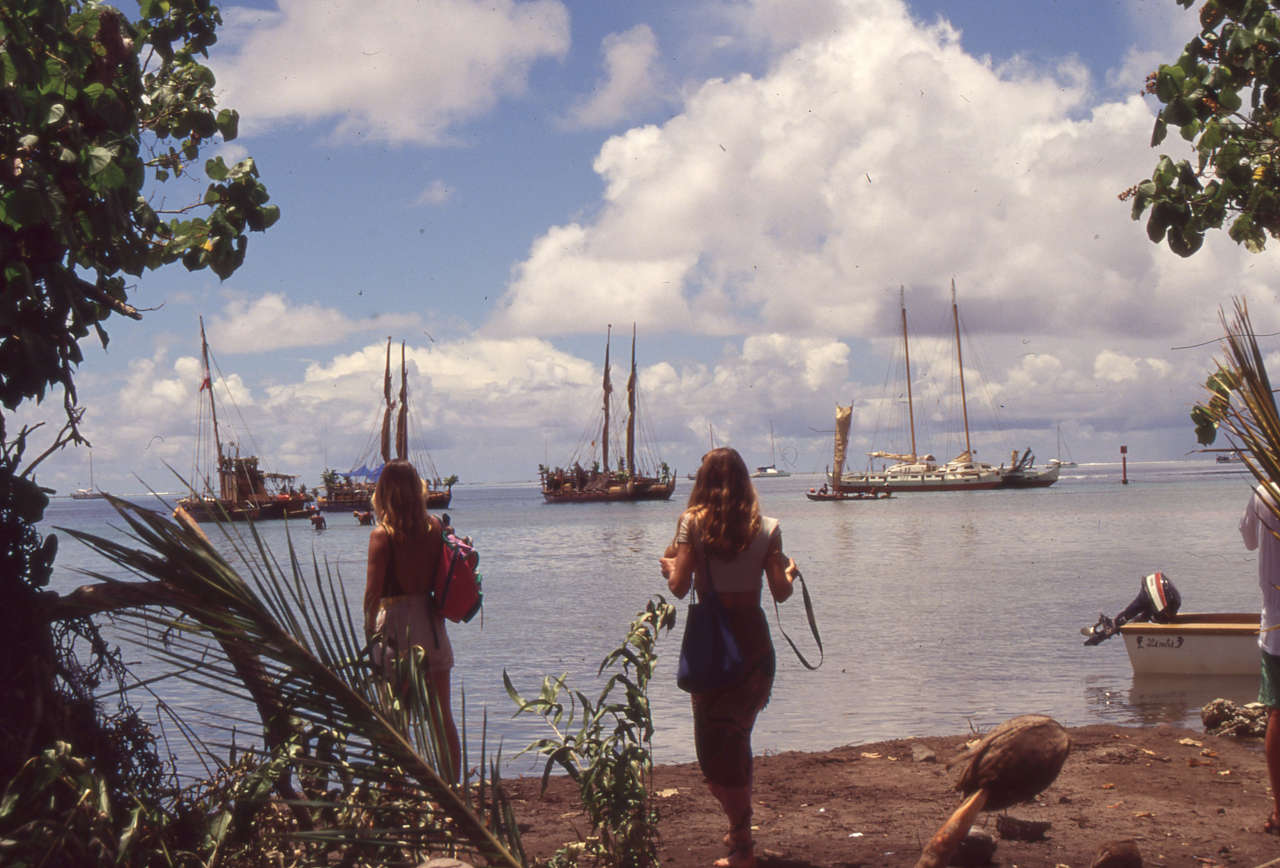
Canoeform Craft
For four years, my partner, Hanneke Boon, and I with a number of interested sailors have been sailing in the Pacific and Indian Ocean aboard our double canoe/catamaran, the 63ft. 'SPIRIT OF GAIA', studying the last surviving Light Displacement Canoe ships of this great first chapter of Man's sailing history.
Hanneke's chart and Fig. 1 - 4 show what we mean when we write 'Canoeform vessel', the main canoe ships that explored the Pacific and Indian Oceans.
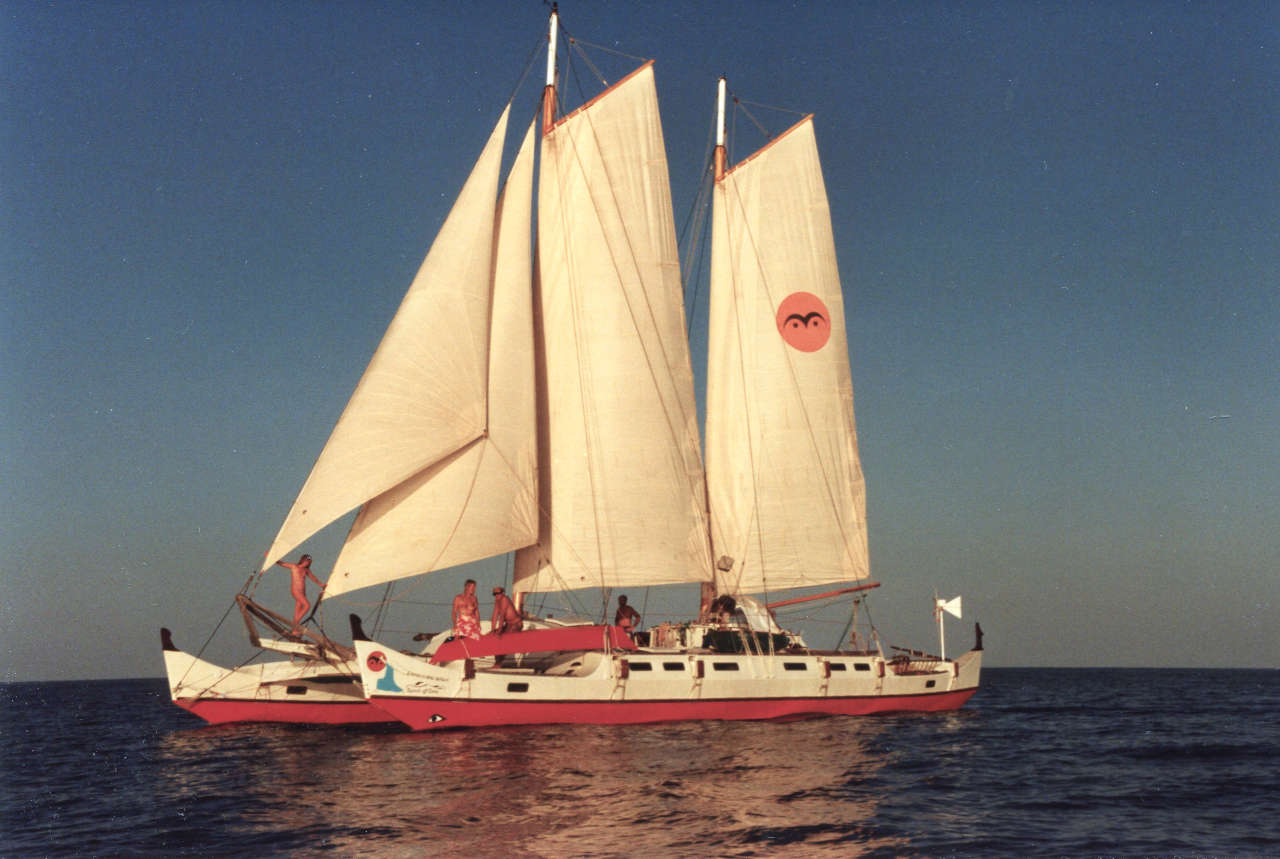
Tools
I have a replica collection of stone hand axes, available to Man 60,000 years ago which look like crude broken stones with sharp edges. However, with them you can cut bamboos or reeds to make a sturdy, seaworthy raft, or you can skin the bark of a large tree to make a short lived, delicate bark skin canoe, but the Dugout Canoeform Craft needs better woodwork tools.
By 30,000 years ago, Man had a kit of stone tools that could duplicate the work of the steel tools of this century. A stone adze, which I saw in use in New Zealand was sending the chips flying at the speed of a modern steel adze.
The 'Dugout' was a natural progress from the bark canoe and is often wrongly seen as the crudest form of boat built. A natural 'tree' log is an ideal structural material that can be subtly shaped and is free from leaking (unless you find a bad log). Some modern yachtsmen are gluing hundreds of strips of wood together, i.e. 'Strip Planking', to get the quality of wood construction inherent in developed carved dugout hulls."'
When big trees are not or no longer available, you have to develop planked canoe hulls. Sewn or lashed together planked hulls were used all over the world. The sewn boats that have survived in the Pacific and Indian Ocean until today show the strength and durability of this plank joining method and its suitability for hard long distance sailing, though like all planked boats they can leak.
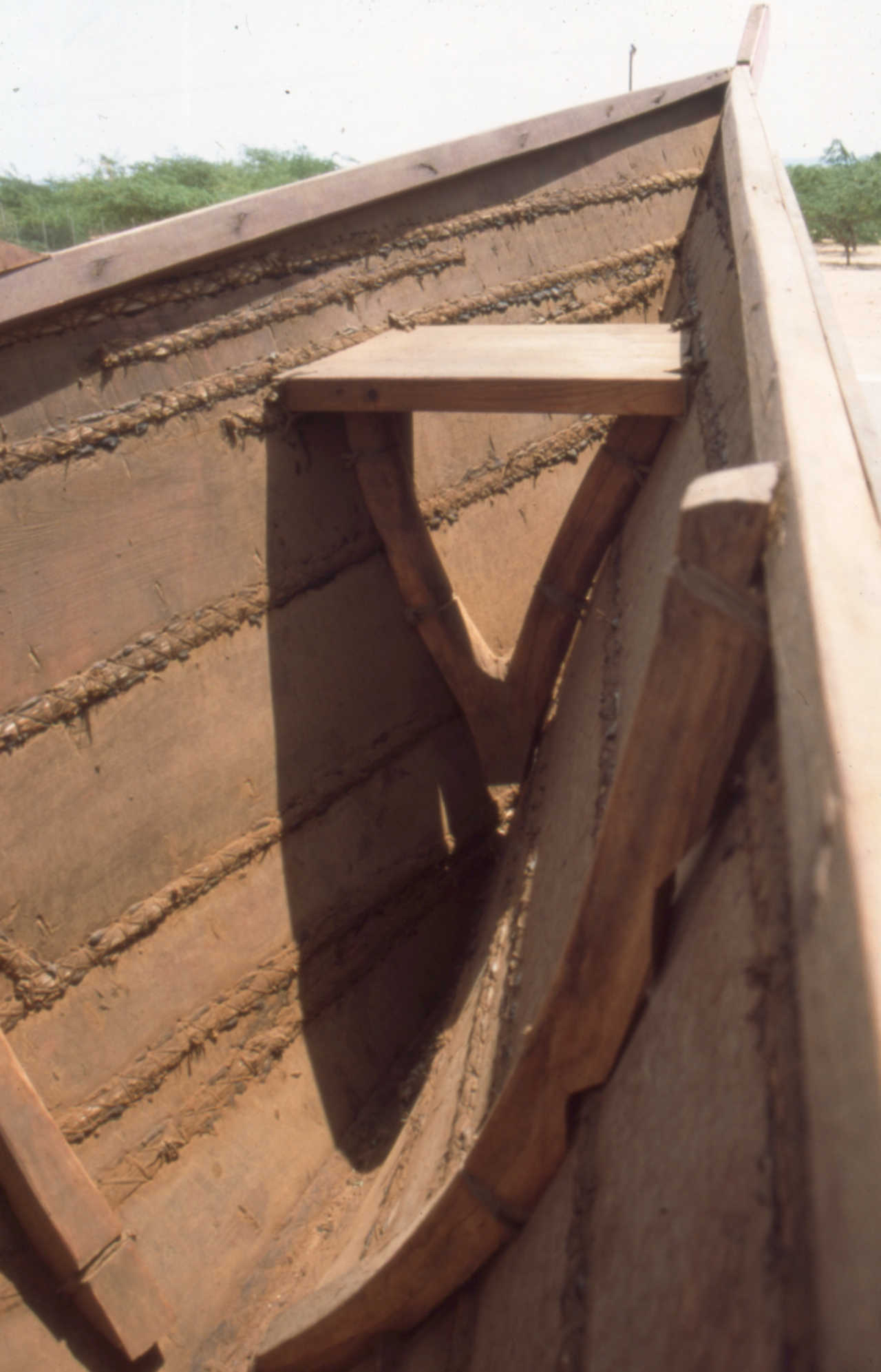
Dugout hulls have the rigidity to crash land on a beach and be hauled out. Sewn boats have the elasticity to do the same, whilst modern light displacement yachts require very expensive wheeled boat hoisting vehicles to lift them and their slender fin keels out of the water for repair, painting or stowage!! Whilst going aground - horror, horror!!
Single canoeform vessels up to 60ft. (19m) long, with a hull length/beam ratio of between 12:1 and 20:1, are ideal for river use. Jungle and heavily wooded country is easier to move through by river than hacking your way over land. For sea use, with their narrow beam, to resist capsizing by wave and sail they need to be stabilized.
The slower, heavier, beamier rafts with a length/beam ratio of 3:1 - 5:1 have always existed along with the canoe. It does not take much thinking for practical sailors to combine 2,3,4,5 canoes into a stable load-carrying raft.
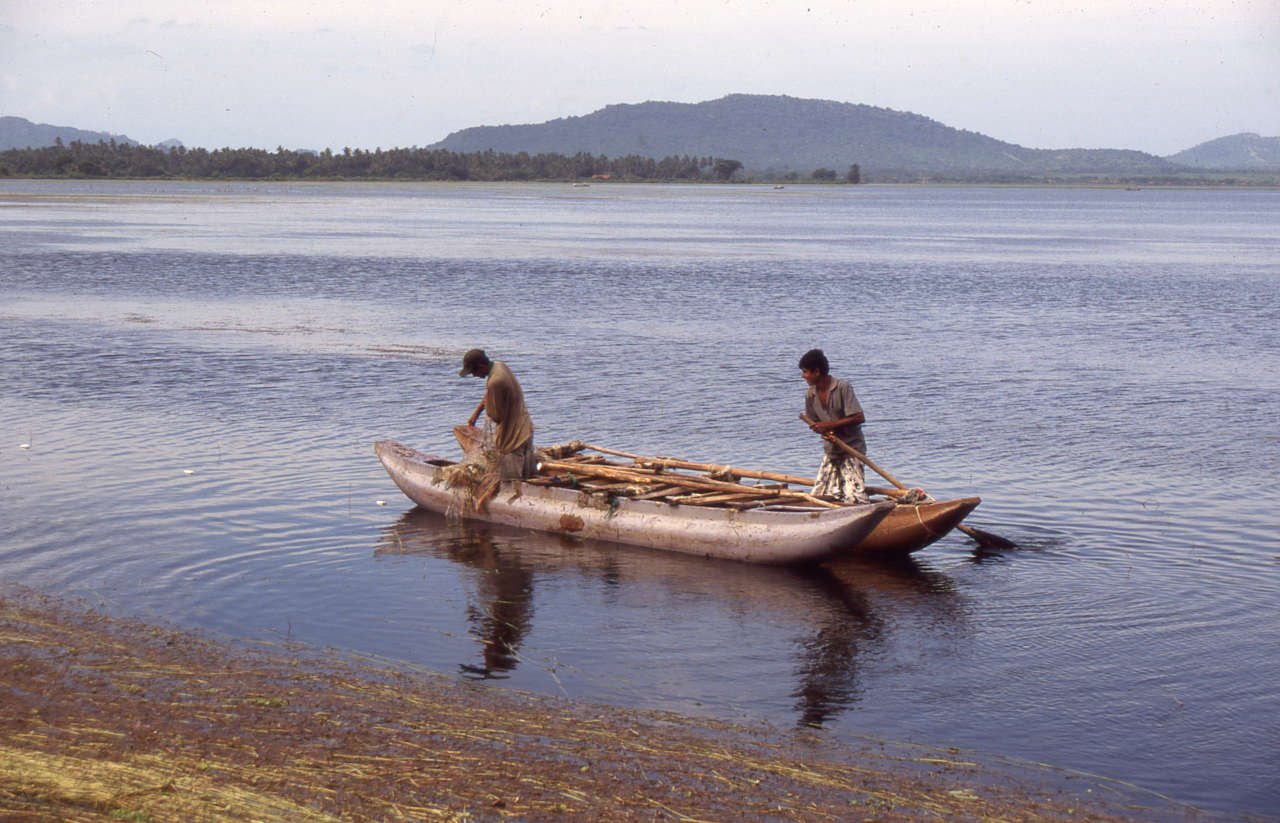
A canoe raft of this type, the Lakatoi, existed in Papua New Guinea into the 1950s (and, I believe still exists). With several masts, they sailed to windward at least as well as our Squareriggers. Rafts are seaworthy. Increasingly, 'regulators' are demanding yachts to carry small inflatable 'Liferafts for safety'.
When these first canoe rafts got sailing we do not know. Papua New Guineans, builders of the Lakatoi, are descendants of the first human seafarers of 60,000 years ago who colonized the then combined Australia/New Guinea continent.
The Double Canoe
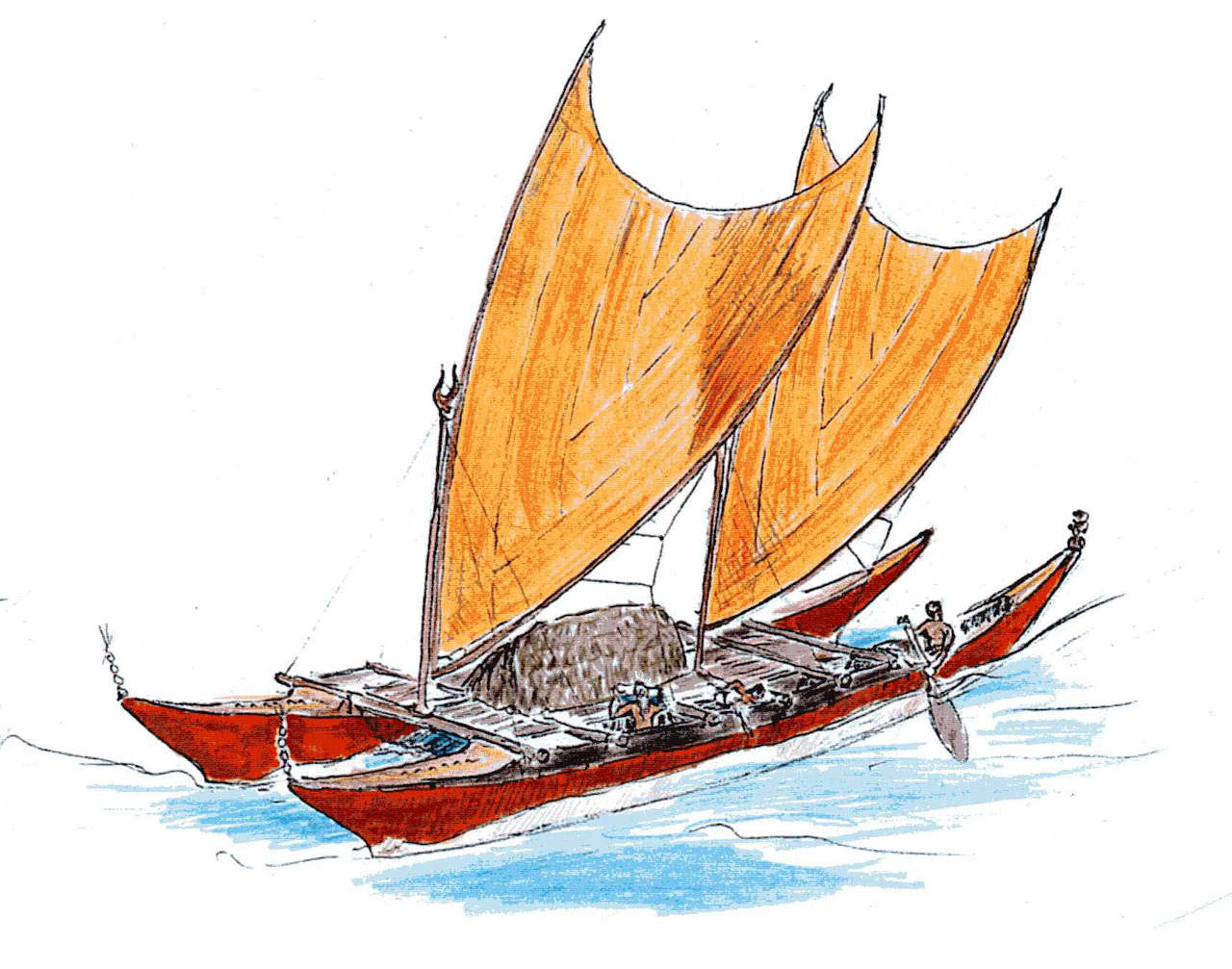
What we do know is that when Europeans began sailing in the Pacific in the 17th century they met over a wide area Double Canoe 'rafts' - as in Fig. 1. This is a typical Double Canoe 'Raft', known to Polynesians as 'Vaka' or 'Pahi' and to Western sailors who call its modern version, a 'Catamaran'.
Purists, like myself, have argued that the ancient and modern double canoes should not be called catamarans because catamaran comes from the Tamil word katta-maran, meaning tied logs. Perhaps, on reflection, the word catamaran, even though of the wrong language, is the right word to describe past and modern double-hulled Raft vessels. I have been sailing them offshore for nearly 45 years and can be allowed to be realistic in describing them as 'Rafts', for the stability calculations are the same as for the raft, and their 'feel' when sailing is comparable to a speeded up raft.
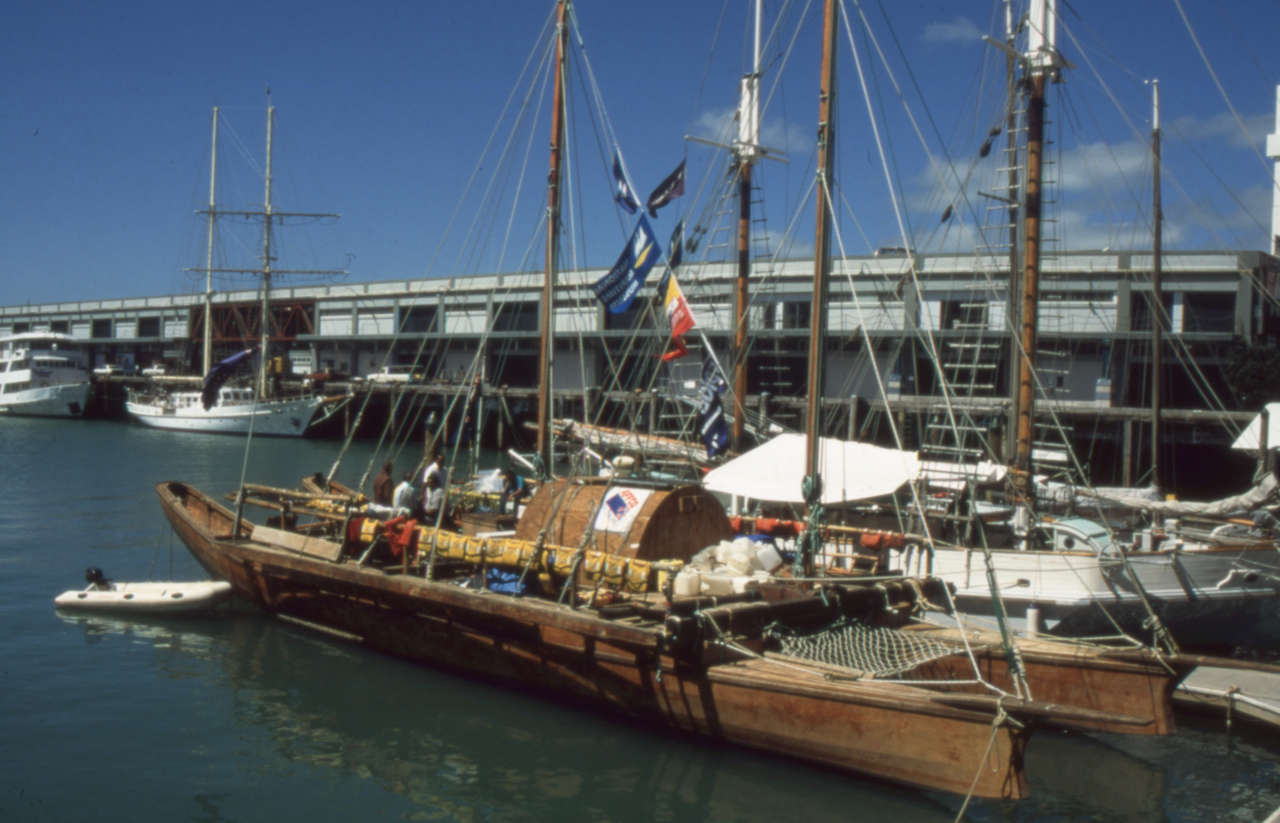
Double Canoe Sailing Rafts sail without heeling or rolling. Their large deck areas allow space to build fair sized deck cabins either in bamboo and mats as in the ancient canoes, or elaborate fibreglass houses as on the modern Catamarans.
The miniumum wave drag and wetted surface of the two canoe hulls give the stable raft shape a good, or high, speed potential. These inherent qualities have made the modern Catamaran, developed over the last 40 years out of the ancient Pacific craft, a successful part of the modern sailing scene.
The Double Outrigger Canoe
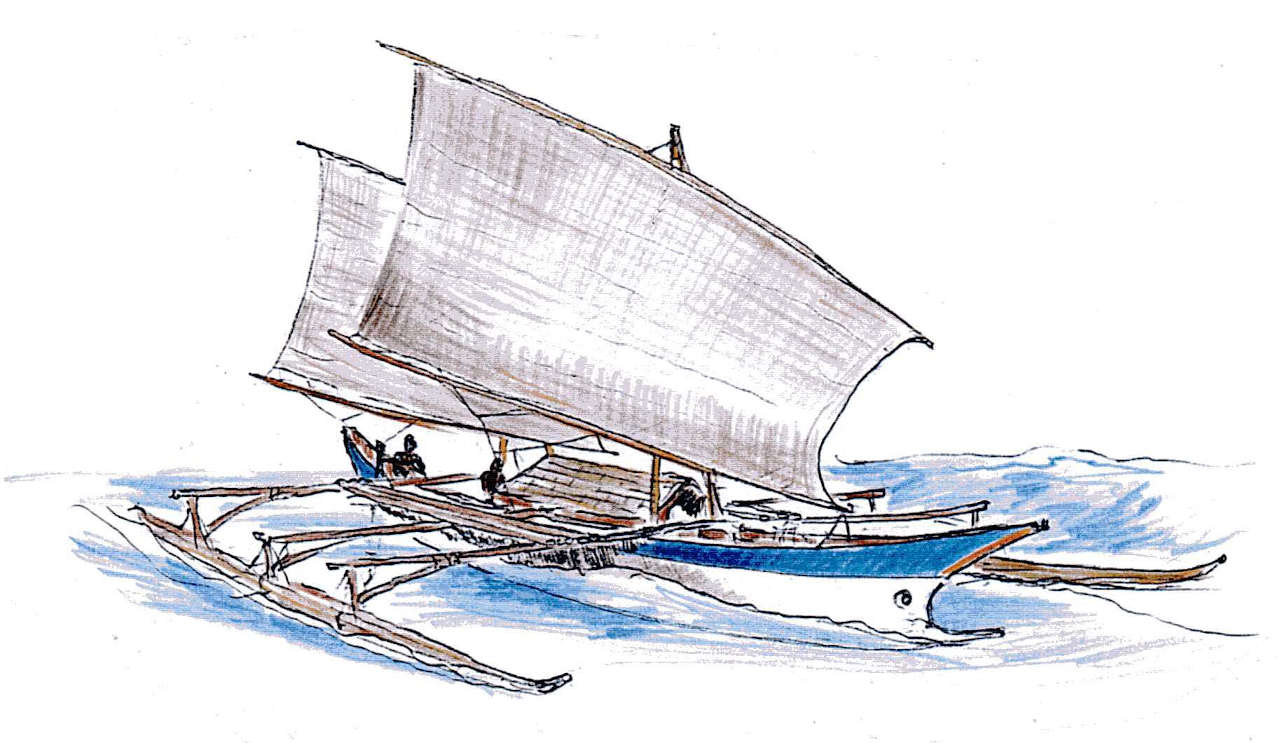
Another modern craft developed out of the canoeform past is the Trimaran, a word I dislike. It is a mixture of the Greek 'Tri', meaning three, and the Tamil 'maran'. It signifies the mixed up Western modern design approach to the Double Outrigger. Fig. 2 is a Double Outrigger of the type used in the settlement of Madagascar from Indonesia about 2,000 years ago. Today, the Double Outrigger Canoe type is sailed from the Philippines (where with 4 big outboards, when used for smuggling, they can outrun many high speed Naval patrol craft), through Indonesia, to Madagascar.
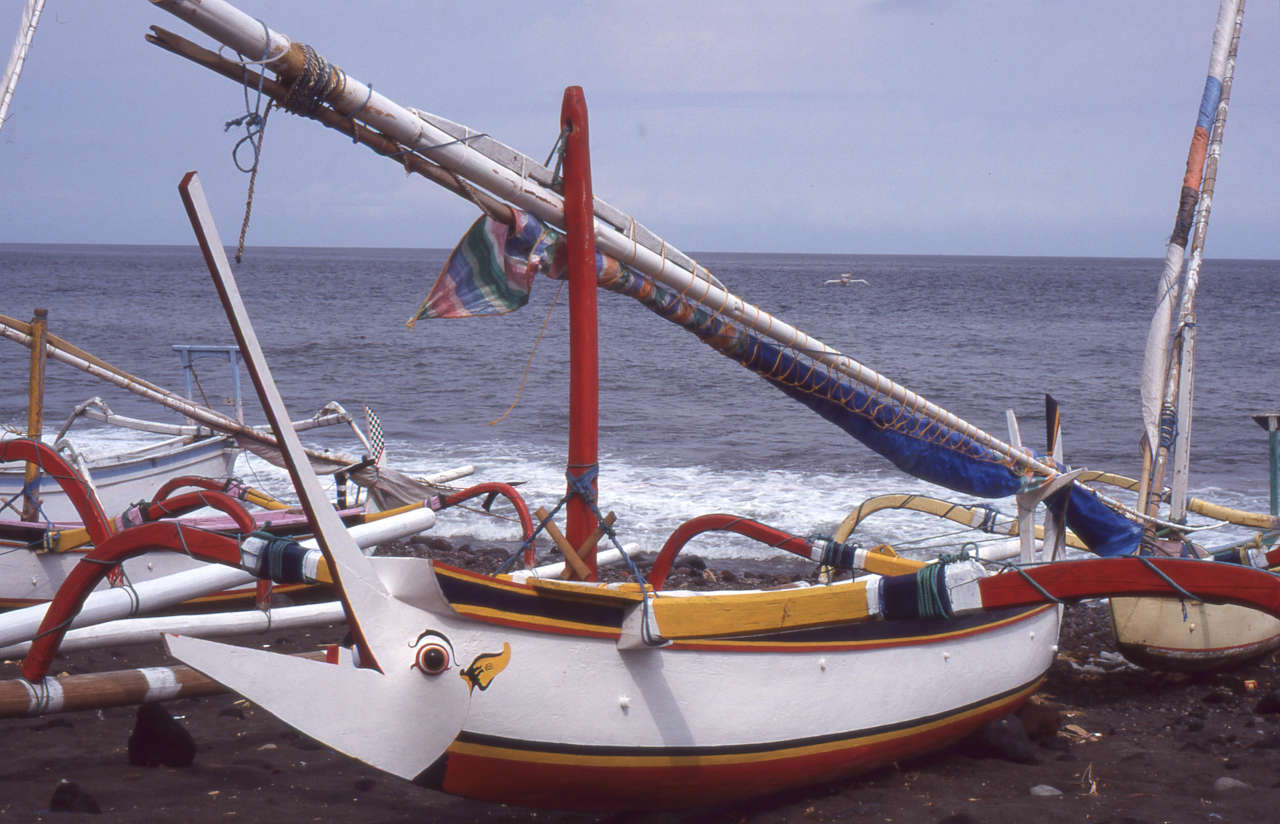
The present day Balinese 'Jukung' is one of the most beautiful of these double outrigger craft. To see them ride white crested waves, their floats balancing their main hull like gentle hands, or swooping up to crunch land on the beach, is to observe a kinetic art form. Technically, the hulls are superbly shaped dugouts, semi-circular in cross section with greater buoyancy aft of the hull centre. An important part of the design is its outrigger floats, made of special thick bamboo, which are 1/3 longer than the mainhull with 1/6 projecting forward and 1/6 behind the main hull and have 30% of the buoyancy of the underwater section of the mainhull.
The Single Outrigger Canoe
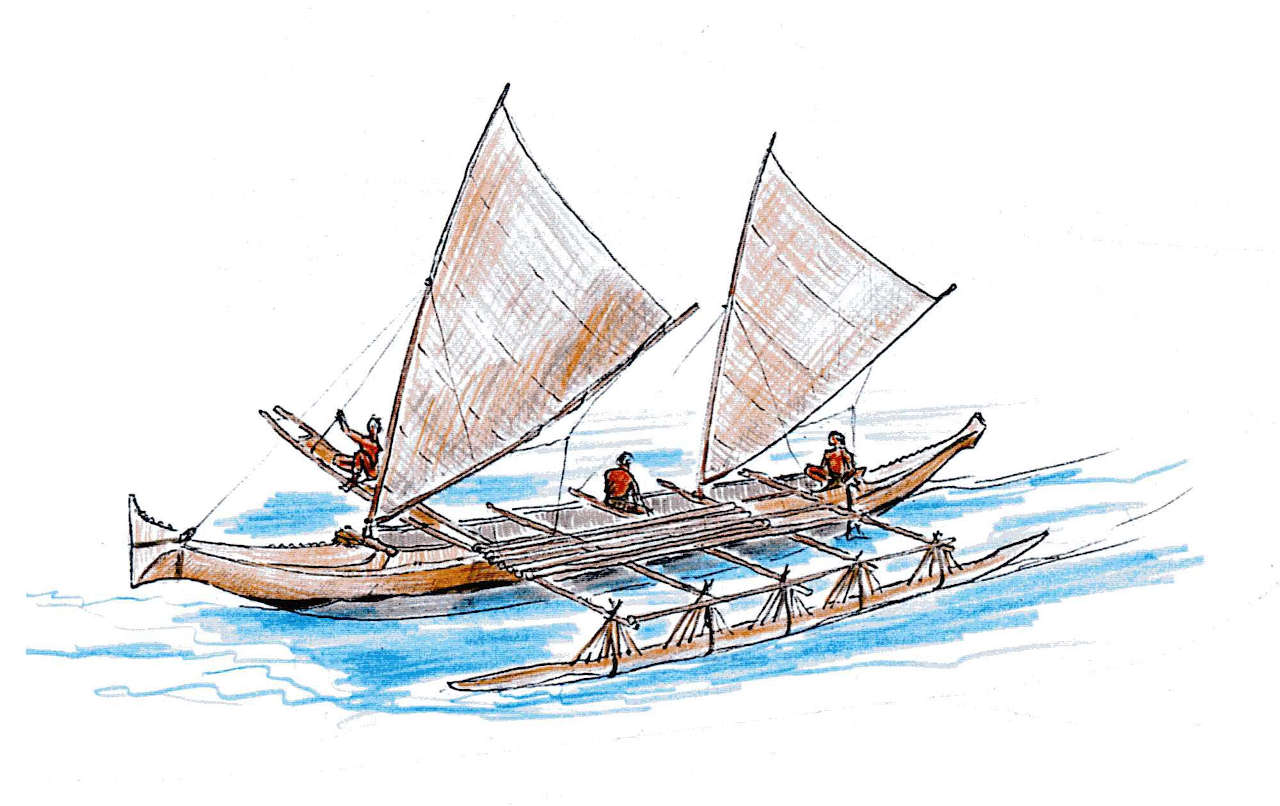
Catamarans and trimarans are to us, certainly in their present day form, well-known craft, but the canoe with just one outrigger is in our waters nearly unknown. (see Fig. 3 & 4)
However, to-day in the area of Indonesia and the Pacific Ocean they survive in sizes from 12' to 30', made out of carved logs, planks of wood or plywood and in the case of modern, expensive racing team paddling canoes, glass and carbon fibres.
In the Melanesian areas of the Pacific, like Vanuatu (former New Hebrides) and the Solomons, the small canoes are as common as bicycles in Holland. They are used for personal transport, fishing and as small trucks to carry produce from main island gardens to the smaller offshore dormitory islands. (see photos: Maskelyn canoe carrying log and canoes on beach)
Different Ways Of Tacking
Sailing outrigger canoes are sailed with two distinct sailing techniques. The first type of outrigger canoe - (Fig. 3) has a distinct bow and stern. It tacks like a Western craft with the bow going through the wind. On one tack the float is to windward and has less stress on it. On the other tack, the float is to leeward and is pressed into the sea. To prevent the submergence of the float a balance board is added on which the crew as moving ballast can sit or stand.
The second type of Outrigger Canoe (Fig. 4) usually called the proa, always has the float to windward. To tack, you turn the forward bow away from the wind and, when beam on, change the sail and mast positions, then turn what was the stern into the wind, tighten up the sheets and away you go on a new tack. (It is called shunting by Western writers). To assist tacking, you need a specially designed hull profile with a symmetric fore and aft keel line and with a similar bow at each end.
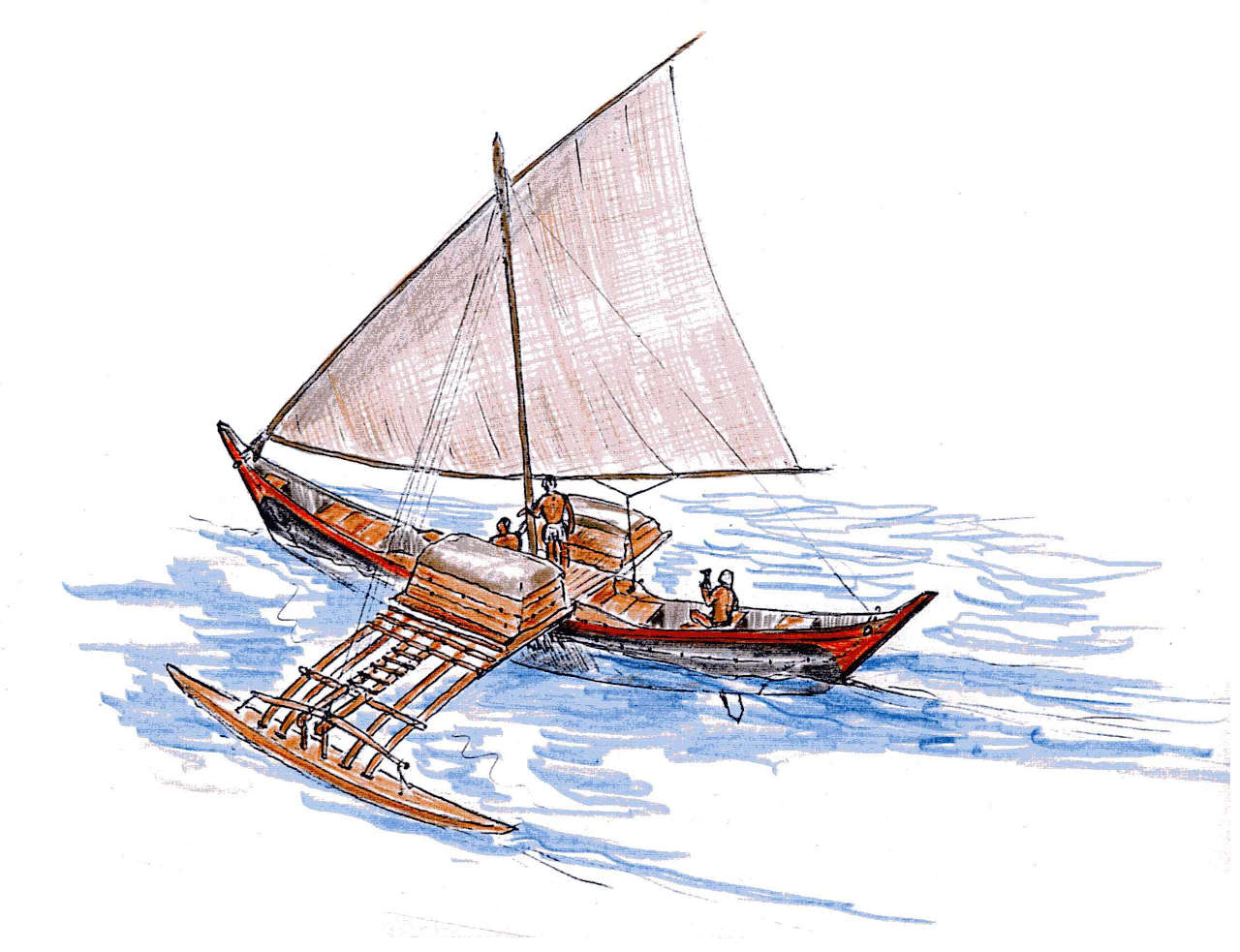
During our 4 years of seasonal sailing in the Pacific and Indian Ocean we had close experience of both types of sailing outrigger canoes. Both have advantages and disadvantages in building and sailing and are capable of sailing in turbulent coastal waters or offshore with a chance of meeting storms.
The Outrigger Canoes Of Vanuatu
In 1996, studying Melanesian sailing craft, we sailed into Lelepa Island, Vanuatu. Two small sailing canoes were launched off the beach to guide us 5 miles into the anchorage (see photograph). They were keen sailors and sailed hard keeping ahead of us. Our speed log showed 6 knots. Later, on measuring the canoes, they were about 16ft. long. Using the speed/length ratio formula, these simple outrigger canoes with crude sails were sailing at a speed/length ratio equalling that of displacement racing monohulls (i.e. 1.5 x WLL).
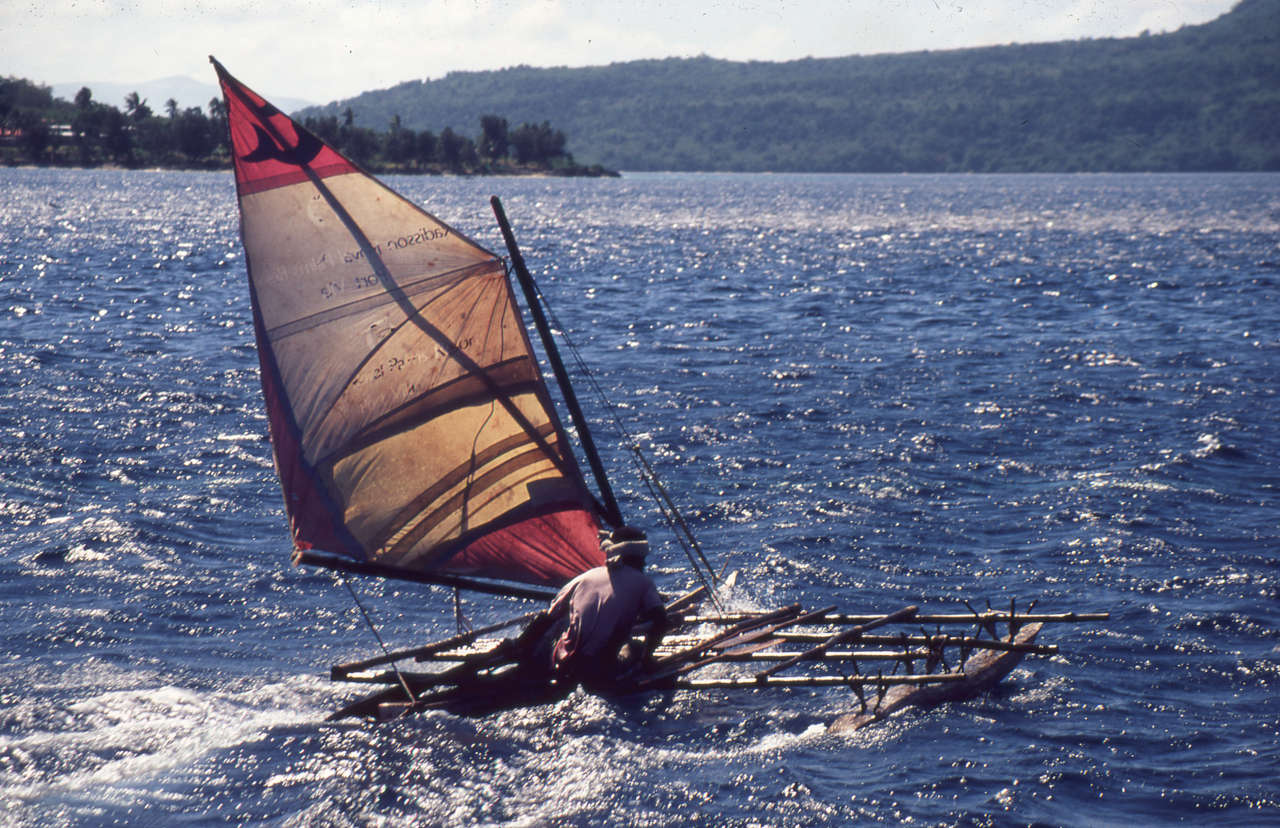
The chief canoe builder, using a local softwood, could carve out a 16ft. dugout hull in two days. Unpainted, these softwood canoes have a life of at least 4 years. Nor were the experienced builders blindly following tradition. They understood the why and how of hull design.
Sailing aboard our 63ft. Double Canoe, one old canoe builder hanging his head over the bow studied carefully our V-eed hull entry wave pattern, then said that he was going to modify his special Racing Canoes to have a more V-eed entry. As he had no 'Recreational Craft Directive' official to consult he could achieve design development in 2 days.
On one island in the Maskelyns (Vanuatu) we met the people of a village which had run short of softwood trees. They wanted to build in plywood and asked us whether we could give them any advice.
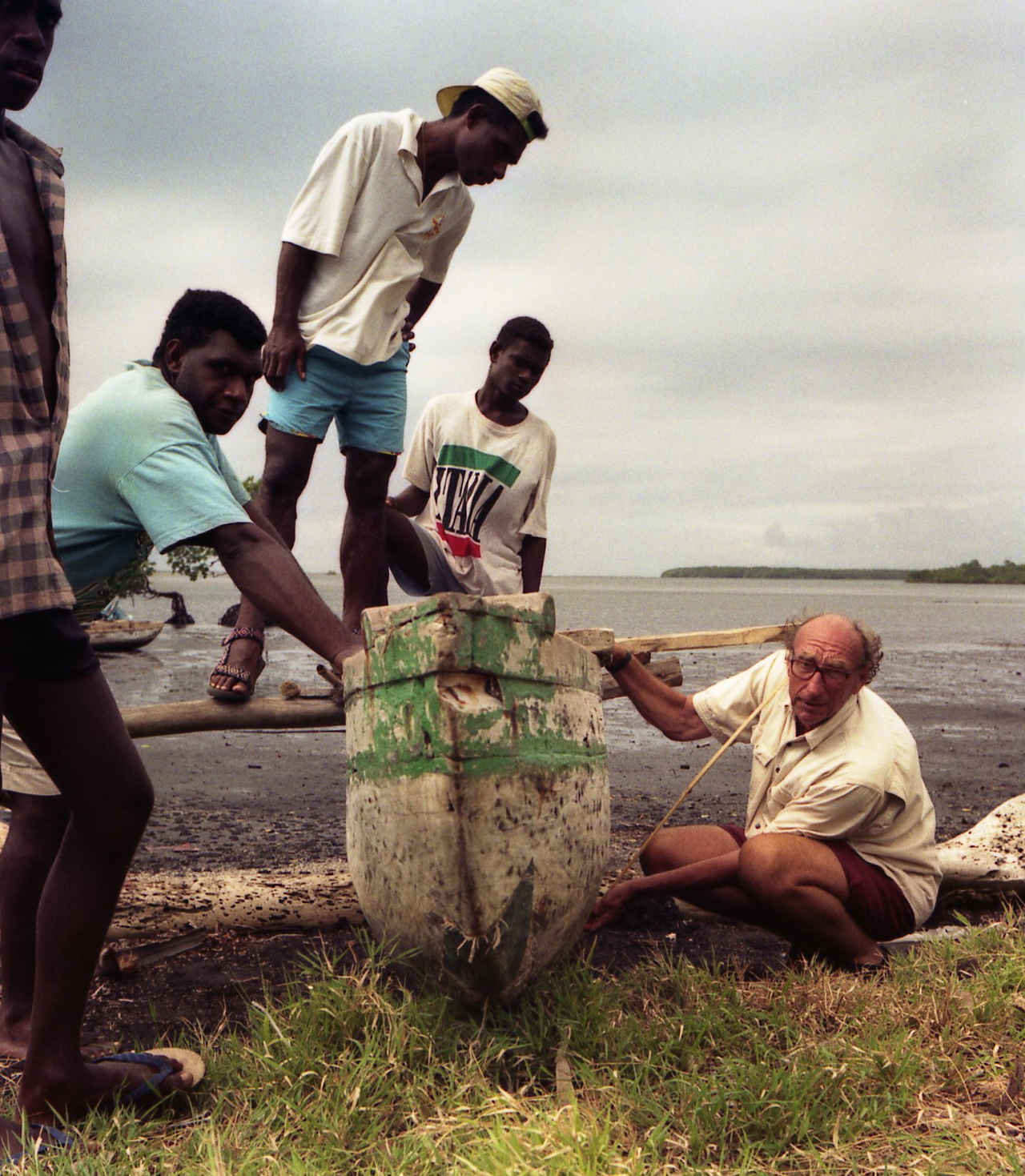
For them we designed the 16ft. 'MELANESIA' outrigger canoe made out of 2 sheets of plywood, which we exhibited at the 1997 'Wooden Boatshow' in Greenwich. It has been of great interest to Western sailors.
From sailing studies of the 'MELANESIA' it does seem that a major factor in sailing outrigger design is Flexibility in the structure, crossbeam attachment, float attachment to the crossbeam, mast and sail. When sailing, the craft seems to 'wriggle' its way to windward, and the flexibility of crossbeam, mast and sail seem to add to stability. When the float is to leeward there is less drag than we expected.
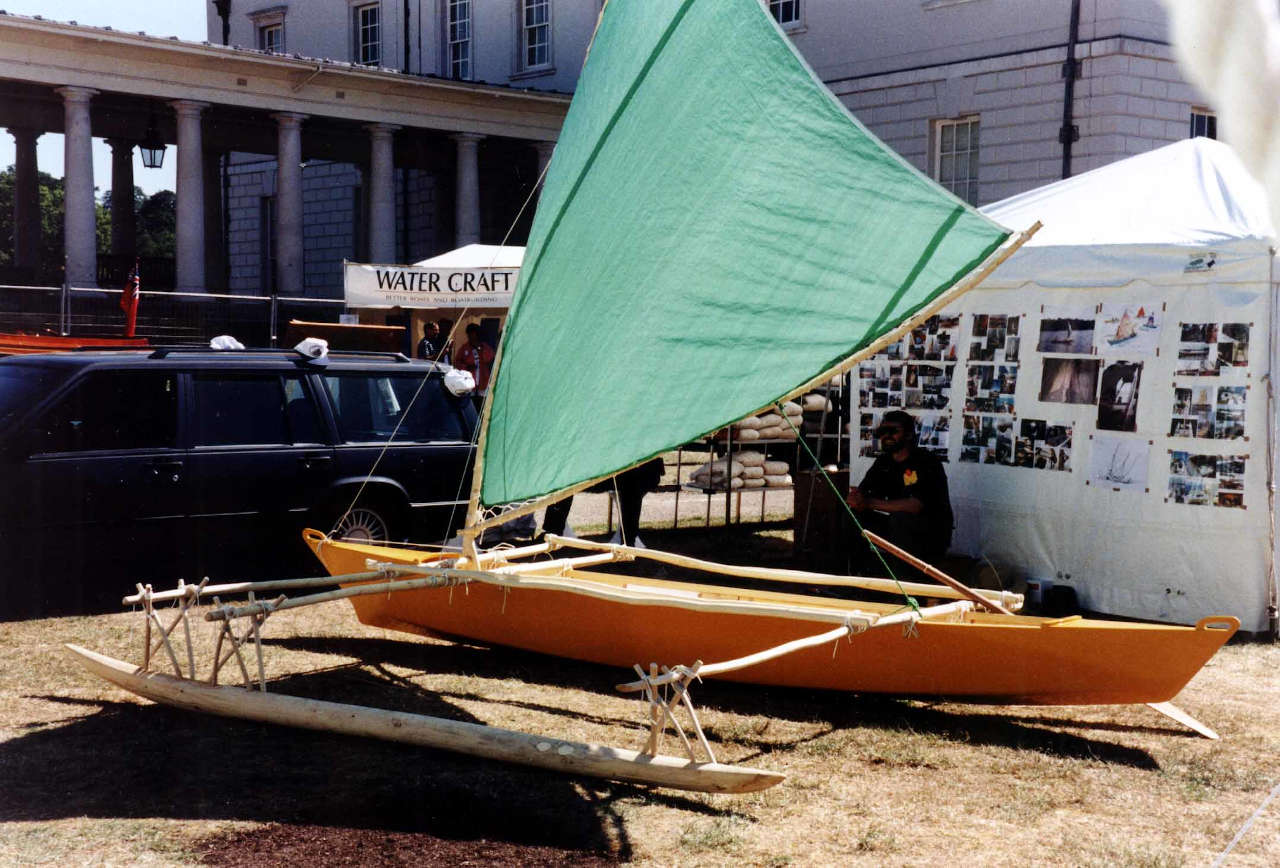
The Outrigger Canoes Of The Polynesians
Outrigger fig. 5 is a Tikopian outrigger. There is a saying about boats: "If it looks right, it is right." Tikopia is a 'Polynesian' island in the Solomon Islands, which are part of Melanesia. I discovered one of these craft in 1995 in the Imperial War Museum in Auckland, New Zealand, half hidden in the small, crowded hall of 'Pacific Canoes'. It was 9m long (see photos). At first glance, I fell in love with this Tikopian canoe. Then, from a small plaque, I found out that it had been in the museum for 80 years, a Sacred canoe presented to the museum when the island was 'missionized' (they objected to the 'fun' with the vahines that went on at the beginning and end of the voyages). It was probably built nearly 100 years ago and was a genuine hull form from the Pacific sailing past.
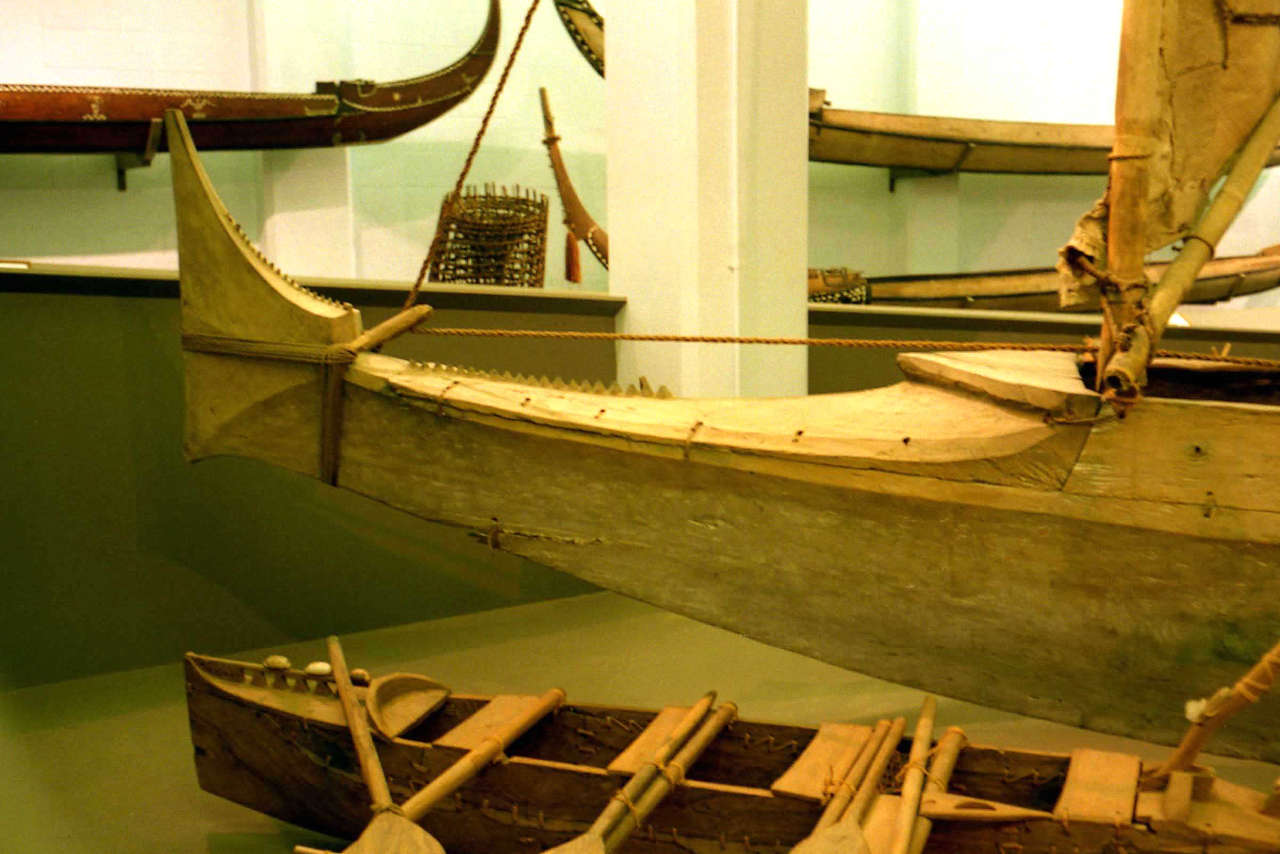
The keel profile is a graceful curve, and its long overhangs would gently lift in rough seas or ride through surf. The cross section of the hull was an exquisite rounded V. (See photo). In all respects, this sacred canoe was sculpted by a genius of design and wood shaping ability.
The question was, how would this canoe or a bigger, say 45ft, ocean cruising version sail? During the winter of 1996, out of curiosity, we laid a scaled transparency of the 9m Tikopian canoe lines on the lines of our 63ft. 'SPIRIT OF GAIA' hull. The keel lines and cross sections practically matched. It was an inspiring and humbling moment.
In our 1996 sailing season we made the effort of sailing to the lonely island of Tikopia, to meet the Chief whose great-grandfather had presented the craft to the museum.
From sailing to Tikopia I know the roughness of the seas they sailed in and of the regular 150-200 miles voyages they made to the Melanesian Vanuatu group. I also know from our similar hull form that theirs has sufficient lateral resistance to sail 45 degrees off the apparent wind without making leeway.
On a waterline of 36ft (11m), from our hull form experience the canoe can be expected to attain average speeds of between 1xè LWL to 1.5xè LWL, i.e. 6 to 9 knots. Therefore, this Tikopian outrigger craft would be able to average through rough seas 150-200 miles a day, i.e. in 6-7 days in a force 4 wind one could plan to sail 1,000 miles.

Sea-going canoes of this type and size were recorded all over the Polynesian Pacific, from Samoa to Tahiti and up to Hawaii (Unfortunately, the use of these craft was abandoned in most islands with the coming of the missionaries, and little concrete data remains). We do know , that they were sailed on thousand miles journeys. However, we do not know how often they used the balance board or how difficult it was to use it when the float was on the leeside.
The Micronesian Proa
The solution to the design problem of the float burying in the sea when on the leeside is the major difference between the outrigger canoe and the Proa.
In the vast area of the Canoeform sailing world, there is one area, Micronesia in the NW Pacific, that is but a few chains of small islands and atolls spread over thousands of square miles of ocean. As late as the 1950s, there were sailors there who would sail 500 miles for a few packets of tobacco. There is a report of a 27-30 ft. proa on such a voyage being 'rescued' in a storm by a steamship. The crew of the steamship then observed, that these Micronesians did not perceive themselves as being 'rescued' but as being 'given a lift'. Their proa was the outrigger craft that always sails with the float to windward. The name Proa, I think, comes from the Indonesian boat name Prahu. It has come to mean the distinctive end for end, or bow for bow, tacking technique.
Fig. 6 is a Marshall Island voyaging proa of the beginning of this century. Notice the small but comfortable deck cabins giving shelter from sun and rain. Though the 'WALAP', the local name for such a craft, shown here, no longer sails the seas, in 1992, for the 'Pacific Arts and Crafts Festival' in Rarotonga, the Marshall islanders built for the first time in 20 years a slimmer, 52 x 28ft. faster version of the Walap, the type know as 'Flying Proa', i.e. it lifts its float out of the sea. It is a craft that has been recorded 'flying' at 20 knots. After the 1992 Pacific Arts Festival, it was loaned to the Auckland Maritime Museum in New Zealand where, re-launched in 1995 for the 'Vaka Moana Symposium', being a planked boat, it had dried out and kept sinking. We had it hanging off the stern of our Double Canoe until it 'took up'. While there we made a close study of its construction. Hanneke also had the opportunity to sail on 'him' (canoes in the Marshalls are male!)
All Pacific canoeform craft steer like a sailboard by moving the centre of effort of the sails. Tilting the mast and sail forward, and the craft turns away from the wind. Tilting the mast and sail backwards, the craft goes into the wind. The steerboard/paddle is mainly a trimming device.
On the Double Canoe, the Double Outrigger and the Single Outrigger (Tikopia style) sail and mast movement is minimal.
With the end-for-end proa to get steering balance on tacking, there is a considerable movement of mast and sail, requiring strength, agility and careful teamwork.
The photo sequence (Fig. 6) shows the 'shunting' of this 52ft. racing Walap proa, using 4 strong experienced men. Get it wrong, and you risk bruised fingers, strained muscles and the odd hernia.
On sailing aboard the proa, Hanneke noticed another problem. Get too close to fluky winds, and you can go aback, with minimal or no mast staying on the normal leeward side, the mast and sail can collapse over the beam platform and float.
On our observation of the 52ft. shunting proa in Auckland we, at the time, favoured the outrigger canoe as being easier to handle.
The Sri Lankan Proa
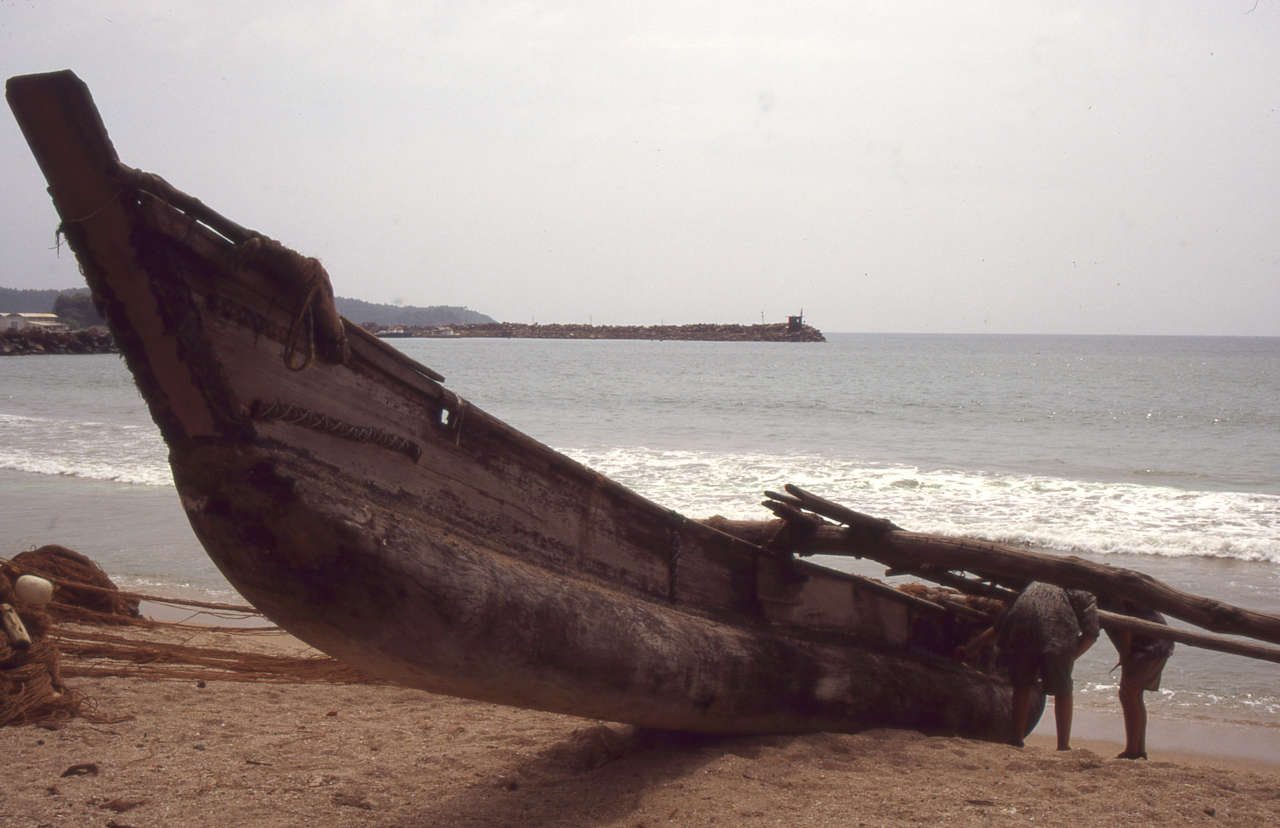
In making that assessmment we were wrong. An easier way of tacking a 'Proa' has been observed by Westerners for 300 years. Holiday brochures of Sri Lanka in the Indian Ocean invariably show the Sri Lankan outrigger sailing craft, called the 'ORU'. But the ORU was seen as part of the Indian Ocean, separate from the Pacific and therefore not seen as a Proa. Of course to the ancient Canoeform World it was all one sailing area.
The ORU tacks end for end like the Micronesian Proa. Hundreds of fishing ORUs still sail the Sri Lankan coast. The Sri Lankan government has encouraged the building of ORUs with fibreglass main hulls, and certain fishing is restricted to sailing outriggers only (like the sailing oyster work boats in the Fal estuary).
So deep is the concept of safety (at sea) connected to outriggers, that a small harbour fishing craft (see photo) made out of a Western yacht dinghy has an outrigger added 'for safety'!!
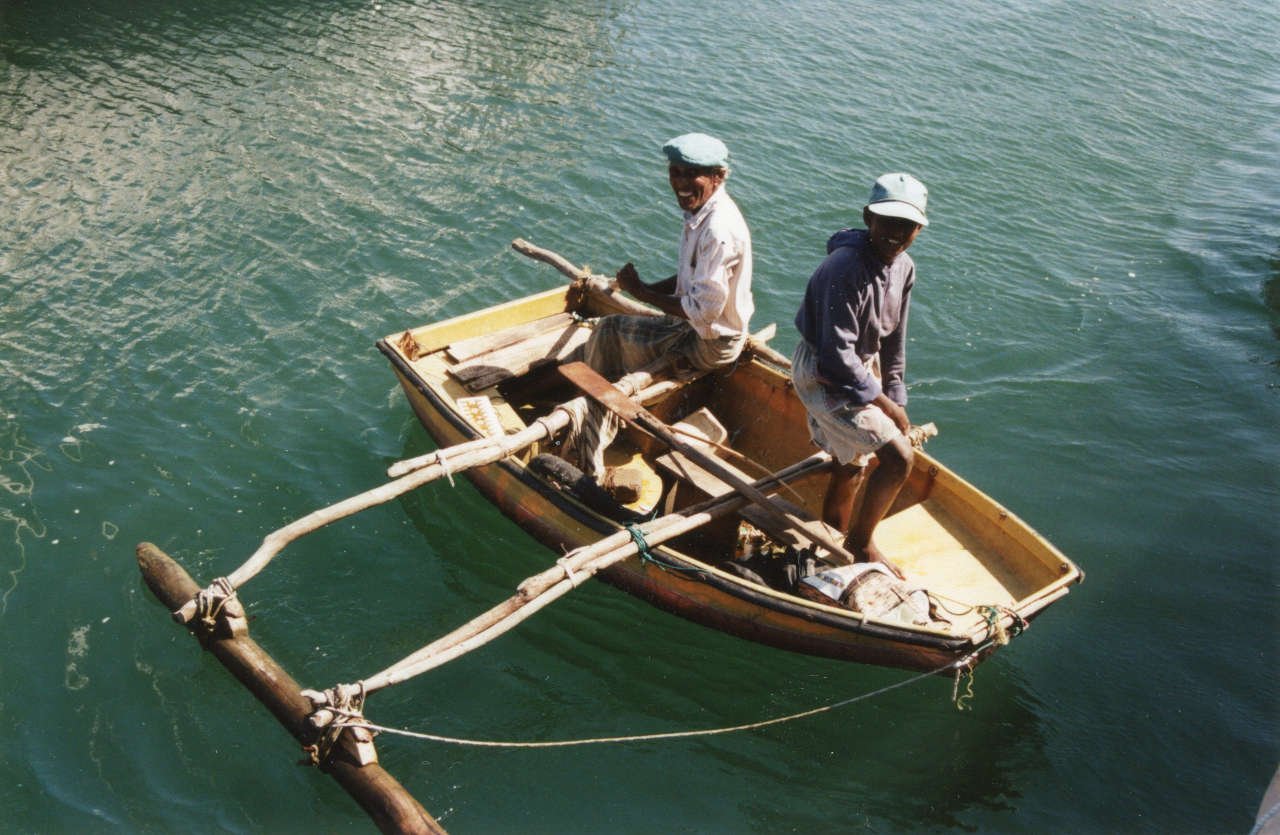
The Sri Lanka ORU would not win any Wooden Boat competition for elegance of form or finish. The first one we measured loomed over my head like an archaeic sea animal. Its long dugout hull was pitted with age and mended with stitched on tingles. As I found out, it was 50 years old. Its built up single plank topsides were sewn on.
Compared to the light woodwork elegance of the Micronesian 'Walap', it was brutally strong and easily repairable. The flat plank overhanging bows had an enormous lift which could not only ride the surf on beaching but also lift over stormy seas. My gut instinct said, I would like to sail one of these craft, and I did, not in strong wind conditions but in the lightest of winds.
Six of us pushed the 1 1/4 ton craft into the sea, and in the glassy calm she was moving out to sea. When the first wind ripples began showing on the sea, the absurd rectangular sail filled like a spinnaker, and the craft was moving at 3-4 knots off the apparent wind.
Light weather sailing ability is as important as strong wind ability. This archaeic looking craft moved well in the lightest of winds. From the crews' description of where their offshore fishing areas were and the time they took to get there, this craft could average 7 knots. Other people reported 10 knots averages in winds which are described as 1, 2, 3 or 4 men winds, i.e. attained with the number of people out on the outrigger beam to add stability.
Once we had a good way on, I said: "Tack". After bearing away bringing the float into the wind, the two men crew eased a few ropes and well... the drawing shows what happened (Fig. 7). This Proa rig, compared to the Proa of Micronesia, needed no big men for heavy lifting when tacking. It is a rig that could be developed to be used by Western sailors.
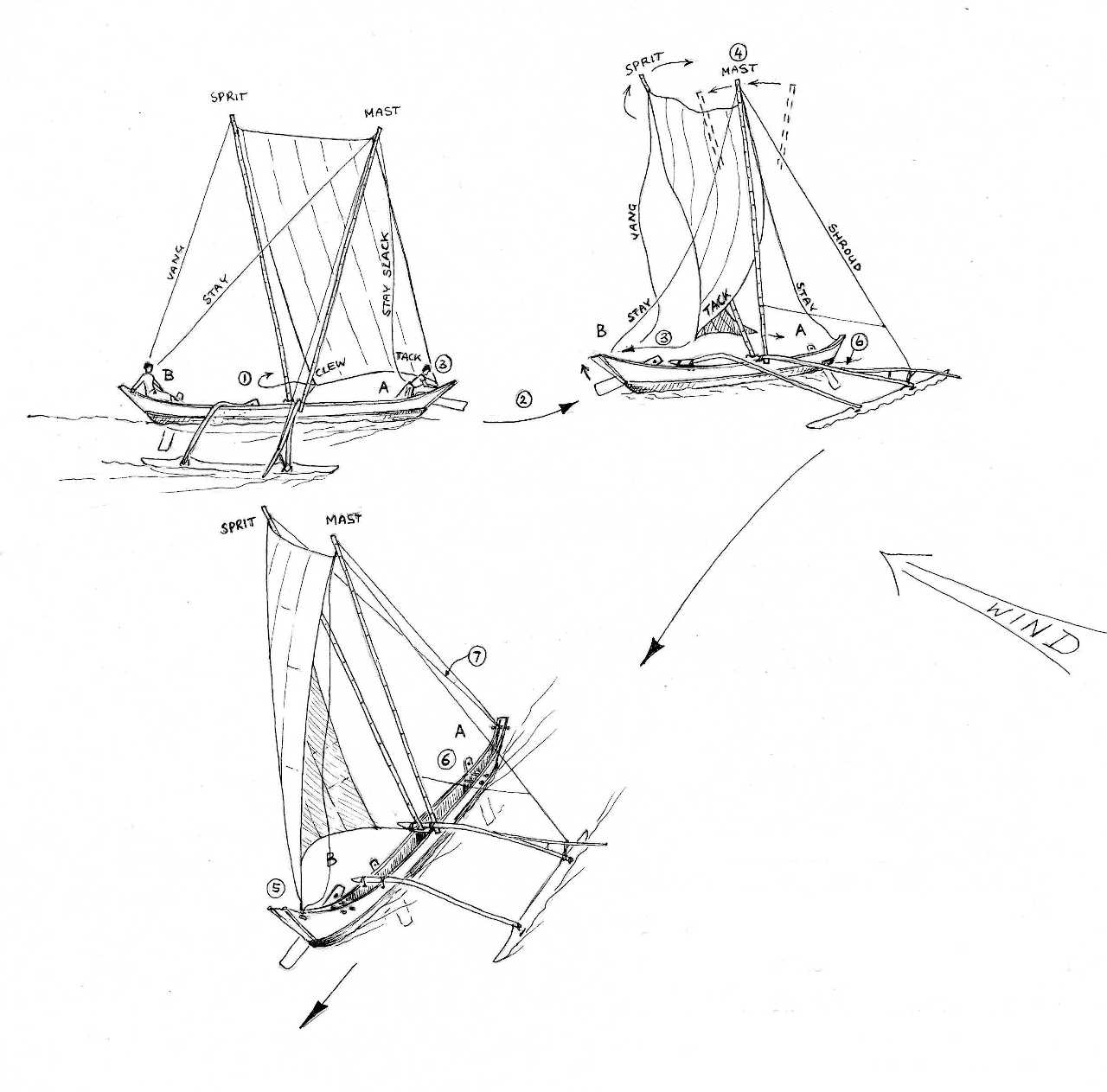
- The sheet is taken between the mast and the sprit by man A and belayed, while...
- The canoe is steered away from the wind by man B
- The tack of the sail is untied by A from the 'bow' and passed between the spars to B at the other end, while the canoe lies beam on to the wind. B raises the rudder
- Meanwhile, by means of a tug on the stay, the mast starts to cant to the other end
- B ties tack down
- A sheets in sail and lowers his rudder
- The vang is passed round the lee side and tightened at the 'stern' by A
A Canoe For The Future
From our studies of Canoeform designs in the Pacific and Indian Ocean we believe that the basic sailing hull of the ancient Pacific sailing canoes is still ahead of Modern Multihulls in subtlety of underwater hull shape. Improvements in the performance of Modern Multihulls, as indeed much 'improvement' of yachts in recent years, have less to do with designers' hull shaping skills and more with improvements in modern sail fabric. Synthetic sailcloth allows you to sail closer to the wind, with more drive than the matting sail of the Pacific, the leather of the Roman sails, the wool of the Viking sails or the flax of the Channel lugger sails."''
"'What defines a modern light displacement yacht is mathematical formulae: sail area/displacement ratio, displacement/length ratio, sail area/wetted surface ratio. Using these formulas for analysis, there is an accepted scale of comparison defining a yacht as heavy displacement, medium displacement and light displacement.
An assumption was made at the Royal Lymington Debate in February 1998 that the fast light displacement boat is a modern concept. We applied these defining formulae to the crude looking ORU (See Fig. 8) shows that the crude looking low cost ORU is in fact by modern mathematical definition, a high speed, performance, light displacement sailing craft!
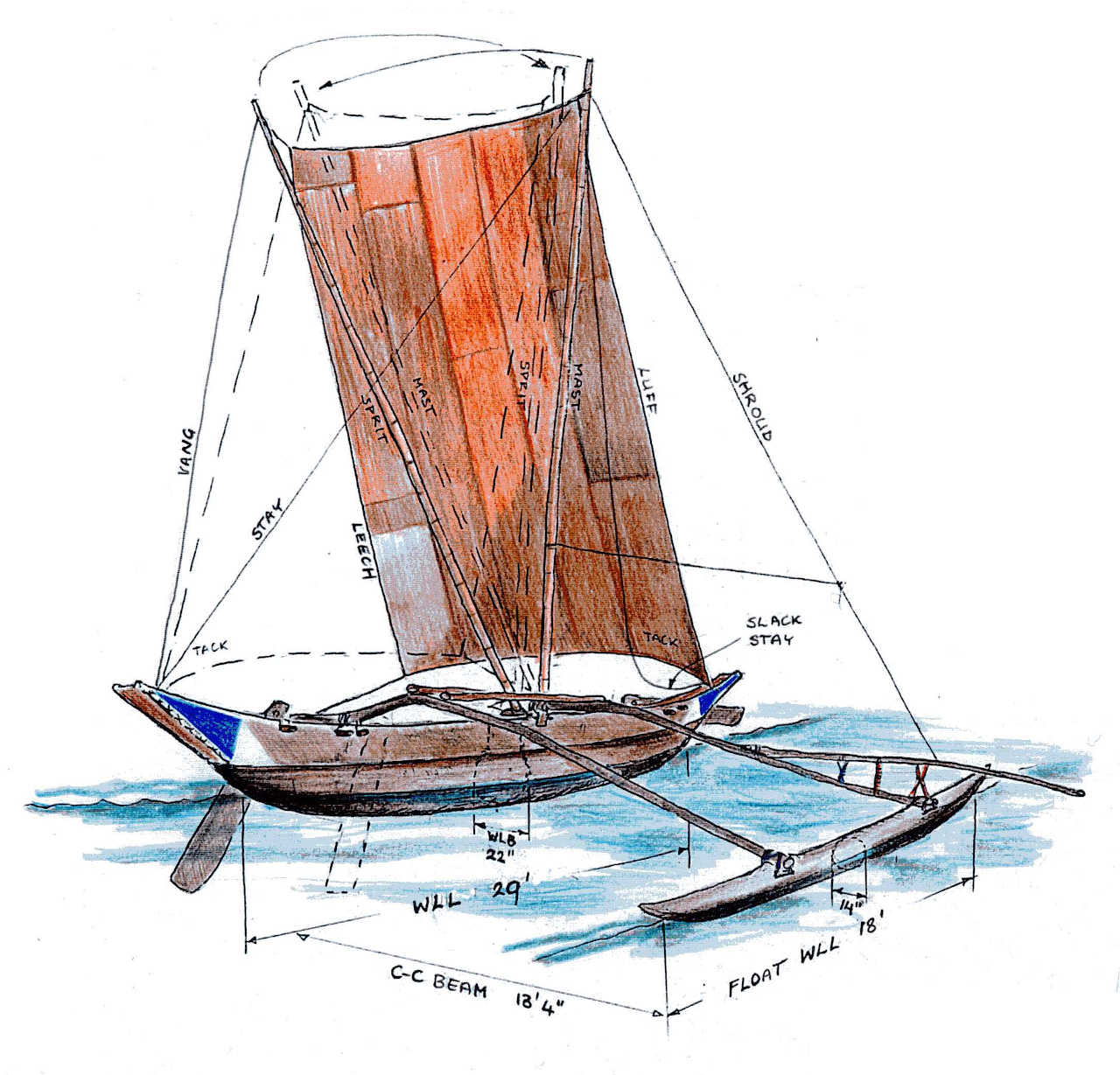
| Sri Lankan Oru | ||
|---|---|---|
| L.O.A | 34' | 10.37m |
| W.L.L | 29' | 8.85m |
| Float Length | 19' | 7.80m |
| Beam C-C | 13' 4" | 4.05m |
| Weight all up | 2760 lbs | 1250 kg |
| Weight of float (approx 30% of hull weight) | 638 lbs | 290 kg |
| Sail area (estimated) | 345 sqft | 31.4 sqm |
| Sail area (reduced) | 280 sqft | 25.5 sqm |
| Ratios | ||
| Sail area/wetted surface ratio | 3.1 | 2.6 (reduced sail area) |
| Sail area/displacement ratio | 28 | 22.8 (reduced sail area) |
| Displacement/length ratio | 51.2 | |
| Speed/length ratio | @ 7 knots: 1.3 x √WLL | @ 10 knots: 1.85 x √WLL |
| Hull length/beam ratio | 15:1 | |
Comparisons
- 2.6 is excellent ghoster (sail area/wetted surface ratio)
- 20 - 22 racing monohulls (sail area/displacement ratio)
- 22+ very high performance monohulls (sail area/displacement ratio)
- 25-30 high performance multihulls (sail area/displacement ratio)
- 50 - 120 ultra light multihulls (displacement/length ratio)
- 1.5 x √WLL is max speed for high performance monohull (speed/length ratio)
- 15:1+ high performance racing cats (hull length/beam ratio)
Using modern multihull design analysis, the 15:1 main hull length/beam ratio and float length/beam ratio equals modern high speed multihulls. The blunt ends of the dugout log ORU give a high prismatic coefficient, again considered an important aspect of modern multihull design. Their semi circular cross section give minimum wetted surface for maximum speed..
The only negative, to me a serious negative, of the Performance Orientated light displacement ORU is its calculated stability which is similar to that used in three modern production 'Performance' cruising catamarans. In use, they all capsized with injuries and loss of life!! I do not recommend cruising for 'fun' with such a low stability factor (Other people do differ). However, from out observations, it does seem that vital extra stability is gained from flexibility in the outrigger and rigging. If one reduces the sailarea to a 2:1 sail area to wetted surface ratio the shown ORU would have a stability equal to many proven stable multihulls.
Treasure House Of Practical Knowledge
The development of modern catamarans and trimarans is an important pointer to the vast treasure house of design knowledge, experience and ideas that exists not on the screen of a computer, but in the traditional small craft still sailing and found in ship museums or books of historic sailing craft.
The outrigger craft of the Pacific are 'Light displacement cruising craft that can be fun to sail'. So is the Norwegian 'FEMBORING' and other Viking era style craft. Traditional craft can offer modern would be yachtsmen who put "'sailing"' before urban comforts, interesting sparkling sail boats, sail boats that can be easily built at affordable prices.

